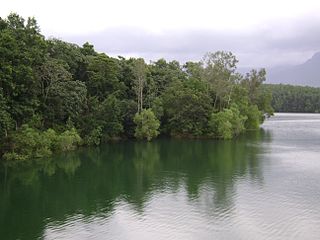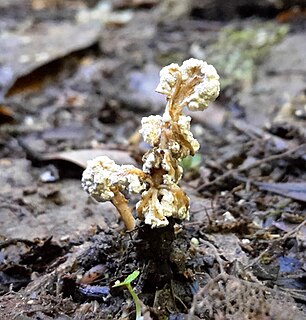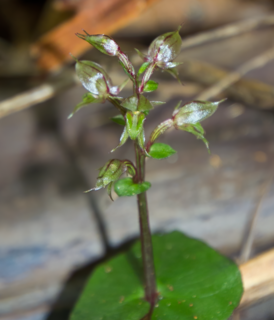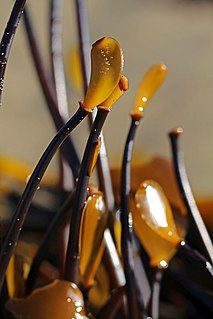
Nutmeg is the seed or ground spice of several species of the genus Myristica. Myristica fragrans is a dark-leaved evergreen tree cultivated for two spices derived from its fruit: nutmeg, from its seed, and mace, from the seed covering. It is also a commercial source of an essential oil and nutmeg butter. The California nutmeg, Torreya californica, has a seed of similar appearance, but is not closely related to Myristica fragrans, and is not used as a spice. Indonesia is the main producer of nutmeg and mace.

Meryta sinclairii, the puka or pukanui, is a large-leaved evergreen tree endemic to New Zealand that grows to about 8 m tall, with the distinctly tropical appearance typical of the genus. There are about 27 species of Meryta, all small, resinous trees of the subtropical and tropical Pacific Ocean.

Myristica is a genus of trees in the family Myristicaceae. There are over 150 species, distributed in Asia and the western Pacific.

The Myristicaceae are a family of flowering plants native to Africa, Asia, Pacific islands, and the Americas and has been recognized by most taxonomists. It is sometimes called the "nutmeg family", after its most famous member, Myristica fragrans, the source of the spices nutmeg and mace. The best known genera are Myristica in Asia and Virola in the Neotropics.

Monodora is a genus of plant in family Annonaceae. It contains approximately 15 species, distributed throughout tropical Africa.

Myristica dactyloides is a species of plant in the family Myristicaceae. It is endemic to Sri Lanka. Some sources have it as a synonym of Myristica malabarica.
Myristica fissurata is a species of plant in the family Myristicaceae. It is endemic to Maluku, Indonesia.
Myristica gigantea is a species of plant in the family Myristicaceae. It is a tree found in Sumatra, Peninsular Malaysia and Borneo.
Myristica grandifolia is a species of plant in the family Myristicaceae. It is endemic to Fiji.

Myristica malabarica is a species of plant in the family Myristicaceae. It is endemic to the Western Ghats in southwest India. It is threatened by habitat loss according to the IUCN Red List. It can reach up to 25 m long and its bark is greenish black, smooth and sometimes reddish.
Myristica maxima is a species of plant in the family Myristicaceae. It is found in Peninsular Malaysia, Singapore and Borneo.
Myristica yunnanensis is a species of plant in the family Myristicaceae. It is found in southern Yunnan, China, northern Thailand, and in Thanh Hóa Province, Vietnam. It is a large, evergreen tree, up to 30 m (98 ft) tall.

The Peppara Wildlife Sanctuary is a wildlife sanctuary in Thiruvananthapuram district of Kerala, India. It consists of the catchment area of the Karamana River, which originates from Chemmunjimottai, the tallest hill within the sanctuary. The sanctuary is named after the Peppara Dam, commissioned in 1983 to augment the drinking water supply to Thiruvananthapuram city and suburban areas. Considering the ecological significance of the area, it was declared a sanctuary in 1983. The terrain is undulating with elevation ranging from 100 m to 1717 m. The area of the sanctuary is 75 km2 with tropical moist evergreen forests and myristica swamps. It is part of the Agasthyamala Biosphere Reserve. Peppara Wildlife Sanctuary is 44 kilometres (27 mi) by car from the nearest railway station, at Thiruvananthapuram, and 49 kilometres (30 mi) from the Thiruvananthapuram airport.

Myristica fragrans is an evergreen tree indigenous to the Moluccas of Indonesia. It is important as the main source of the spices nutmeg and mace. It is widely grown across the tropics including Guangdong and Yunnan in China, Taiwan, Indonesia, Malaysia, Grenada in the Caribbean, Kerala in India, Sri Lanka and South America.

Isaria sinclairii is a species of entomopathogenic fungus mostly infecting the underground nymphs of cicadas. It produces myriocin, from which the synthetic drug fingolimod, a treatment for multiple sclerosis, was developed.

Phellodon sinclairii is a native tooth fungus found in beech forests of New Zealand. It was first described by Miles Joseph Berkeley in 1867 as a species of Hydnum in Joseph Dalton Hooker's work Handbook of the New Zealand Flora. The type locality was on Maungatua. Gordon Herriot Cunningham transferred the species to the genus Phellodon in 1958.

Myristica swamps are a type of freshwater swamp forest predominantly composed of species of Myristica. These are found in three localities in India. Myristica swamps have adapted to inundation by way of stilt roots and knee roots. Myristica swamps are found in the Uttara Kannada district of Karnataka State and in the southern parts of Kerala State. Recently it is found in village bambarde,in Maharashtra's Sindhudurga district.

Acianthus sinclairii, commonly known as pixie cap or heart-leaf orchid, is a flowering plant in the orchid family Orchidaceae and is endemic to New Zealand. It is a terrestrial herb with a single, heart-shaped leaf and up to ten translucent green flowers, usually tinged maroon.

Laminaria sinclairii is a species of brown algae, in the family Laminariaceae. It is native to the lower intertidal zone of the northeastern Pacific Ocean from British Columbia southwards to California.












